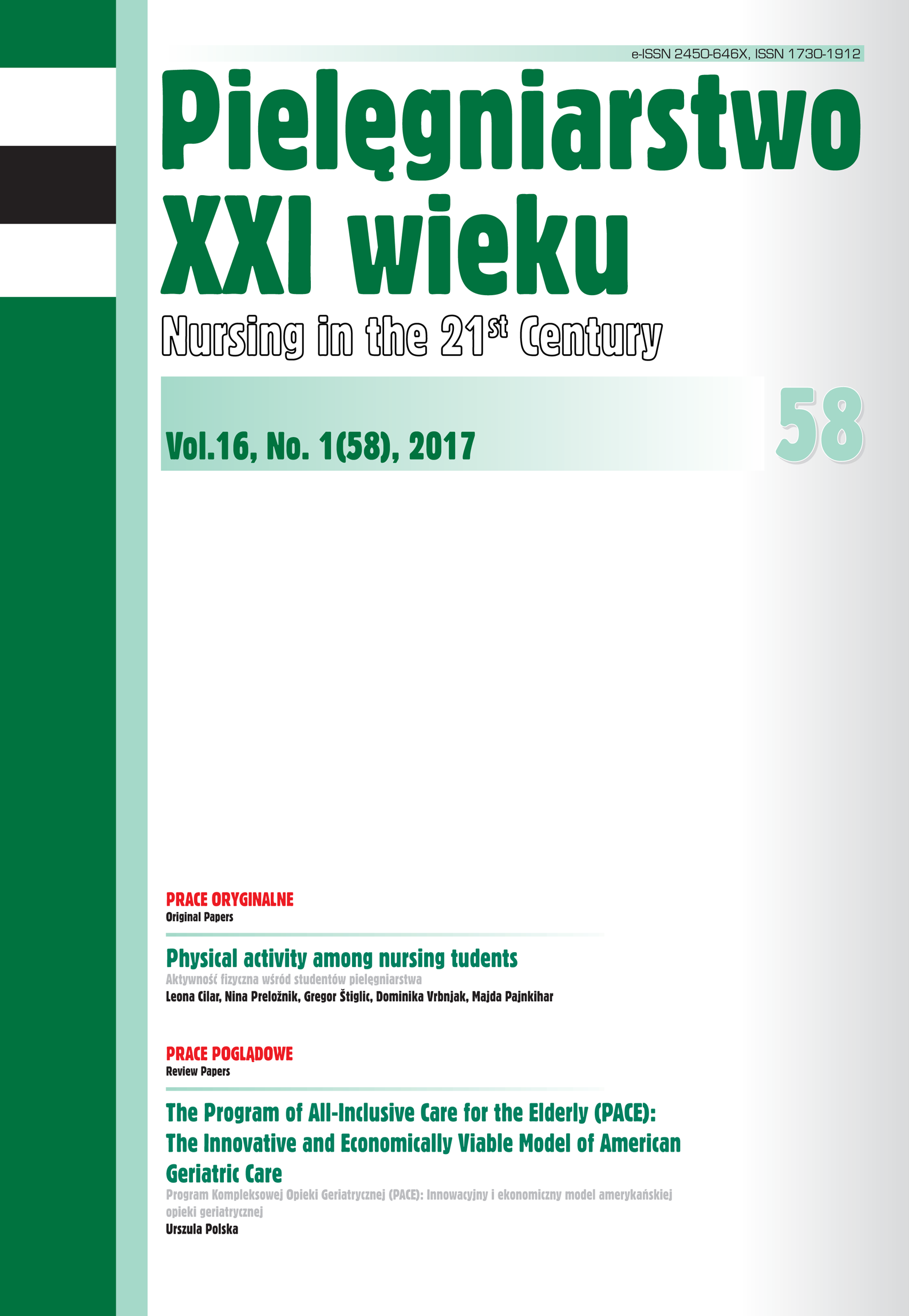Obesity in children - a problem of the contemporary civilization
DOI:
https://doi.org/10.1515/pielxxiw-2017-0007Keywords:
obesity, risk factors, quality of lifeAbstract
OBESITY IN CHILDREN - A PROBLEM OF THE CONTEMPORARY CIVILIZATION
Introduction. In the recent thirty years obesity has become one of the most serious and still increasing health problems among children and adults in the world. Scientific magazines inform about world obesity epidemic. Lack of physical activity, excessive energy supply compared to needs of organism, as well as bad eating habits, have made obesity a civilization disease. Excess weight and obesity lead to premature atherosclerosis development and consequently, to other cardiovascular diseases such as arterial hypertension, thrombosis, cardiac insufficiency, hyperlipemia.
Aim. The aim of the thesis is to present, on the basis of literature, the most important factors which can lead to obesity in children.
Conclusions.
1. Among the most important aspects which can lead to obesity in children the following factors can be mentioned:
- genetic factors - it is probable that mutations within many genes connected with energy efficiency regulation of an organism are responsible for the genetic tendency to being obese
- environmental factors - there is another fact that together with technological development, the level of physical activity has decreased
- psychological factors, like stress, fear, failures at school, family and peer conflicts have become the reasons for compulsive behaviour which lead to excessive consumption of highly processed foods
2. Obesity results in lowering the quality of life in a significant way.
References
1. Mieszczak-Woszczyna D. Otyłość. Pandemia XXI wieku. Med. Ester. Anti-Aging. 2010; 1:47.
2. Mazur A, Klimek K, Małecka-Tendera E. Czynniki ryzyka występowania otyłości u dzieci szkolnych w województwie podkarpackim. Endokrynologia. Otyłość i Zaburzenia Przemiany Materii. 2011; 3(7): 157-166.
3. Podolec P, Kopeć G. Rozpowszechnienie nadwagi i otyłości w Polsce i na świecie. Forum Profilaktyki. 2007; 3(8): 3-5.
4. Szanecka E, Małecka-Tendera E. Zmiana nawyków żywieniowych a problem otyłości u dzieci. Endokr. Otyłość Zaburz. Przem. Materii. 2006;2 (3):102-107.
5. Małecka-Tendera E, Klimek K, Matusik P, et al. Polish Childhood Obesity Study Group, Obesity and overweight prevelance in Polish 7-9 yoear old children. Obes Ress. 2005;13: 964-968.
6. Jodkowska M, Oblacinska A, Tabak I. Overweight and obesity among adolescents in Poland: gender and regional differences. Public Health Nutr. 2010; 13:1688-1692.
7. Pyrżak B, Czerwonogrodzka-Senczyna A, Majcher A, et.al. Ryzyko wystąpienia zespołu metabolicznego u dzieci w wieku 1-7 lat z otyłością prostą. Endokrynologia Pediatryczna. 2012; 1(36): 61-70.
8. Przybylski A, Antonowicz D, Glazer M, i wsp. Otyłość z prawidłową masą ciała wśród uczniów w wieku 16-18 lat. Probl. Hig. Epidemiol. 2009; 90(2): 195-198.
9. Mazur J, Tabak I, Gajewski J, Dzielska A. Nadwaga i otyłość wśród uczniów gimnazjum w zależności od wybranych czynników behawioralnych. Zmiany w latach 2006-2010. Przegląd Epidemiologiczny. 2012; 66(3): 503-508.
10. Kłosiewicz-Latoszek L, Szostak WB. Racjonalizacja żywienia w leczeniu zaburzeń metabolicznych. Nowe problemy w świetle postępów nauki. Polskie Arch. Med. Wewn. CV. Pamiętnik XXXIV Zjazdu TIP. 2001; 211-215.
11. Olshansky SJ, Passaro DJ, Hershow RC, et al. A potential decline in lfe expectancy in the United States in the 21st Century. N. Engl. J. Med. 2005; 352: 1138-1145.
12. Jarosz M, Wolnicka K, Kłosowska J. Czynniki środowiskowe związane z występowaniem nadwagi i otyłości wśród dzieci i młodziezy. Postępy Nauk Medycznych. 2011; 9: 770-777.
13. Dietz WH, Gotmaker SL. Do we fatten our children at the TVset? Television viewing and obesity in children and adolescents. Pediatrics. 1985; 75:807-812.
14. Sinorelli Nm Staples J. Television and Childrens’s conceptions of nutrition. Health Communication. 1997; 9: 289-301.
15. Elliott MA, Copperman NM, Jacobson MS. Pediatric obesity prevention and management. Minerva Pediatr. 2004; 56: 265-276.
16. Lange A, Starostecka A, Graliński SG. Otyłość dziecięca. Klin. Ped. 2001; 2: 295-297.
17. Śladowska-Kozłowska J, Grenda R. Zespół Metaboliczny u dzieci i młodzieży. Family Medicine&Primary Care Review. 2008; 10(3): 1098-1105.
18. Zachurzok-Buczyńska A, Małecka-Tendera E. Zespół metaboliczny u dzieci i młodzieży. Endokrynol. Otyłość Zaburz. Przem. Materii. 2005; 1(3):13-20.
19. Fichna P, Skowrońska B. Powikłania otyłości u dzieci i młodzieży. Endokrynol. Diabetol. Chor. Przem. Materii Wieku Rozw. 2006; 12(3): 223-228.
20. Glińska-Binkiewicz A, Bakuła S, Kusiak-Kaczmarek M, et al. Obesity prevention In childres and adolescents – Current recommendations. Polish Annals of Medicine. 2012; 19:156-162.
21. Palczewska I, Szilagyi-Pągowska I. Ocena rozwoju somatycznego dzieci i młodzieży. Med. Prakt. Ped. 2002; 3: 1-7.
22. Szanecka E, Małecka-Tendera E. Postrzeganie masy ciała przez chłopców i ich matki w odniesieniu do ich stanu odżywienia. Endokrynolotia Pediatryczna. 2014;1(42):45-56.
23. Małecka-Tendera E, Zachurzok-Buczyńska A, Gawlik A. Postępowanie diagnostyczne i leczenie otyłości u dzieci i młodzieży. Endokrynologia Pediatryczna. 2009;1(26): 55-62.
24. Kobusiak-Słonina A, Grzegorczyk J, Mazur A. Ocena sprawności i aktywności fizycznej dzieci szkolnych z nadmierną i prawidłową masą ciała. Endokrynologia Otyłość i Zaburzenia Przemiany Materii. 2012; 8(1): 16-23.
25. Wójta-Kempa M, Lewandowska O. Środowiskowe uwarunkowania otyłości u dzieci ze szczególnym uwzględnieniem środowiska szkolnego. Piel. Zdr. Publ. 2011;1(4): 333-342.
26. Oblacińska A, Weker H. Profilaktyka otyłości u dzieci i młodzieży od urodzenia do dorosłości. Kraków: Help-Med. 2008;14: 25-29.
27. Stefanowicz A, Kamińska H. Jak zapobiegać otyłości u dzieci. Mag Piel Położ. 2007; 6: 20-21.
28. Łysak A, Walentukiewicz A. Trening zdrowotny w leczeniu otyłości. Rehabilitacja w praktyce. 2010; 1: 26-30.
29. Jarosz M. Praktyczny podręcznik dietetyki. Warszawa: IŻŻ; 2010, s. 143-150.
Published
Issue
Section
License
Copyright (c) 2017 Authors

This work is licensed under a Creative Commons Attribution-NonCommercial-NoDerivatives 3.0 Unported License.




